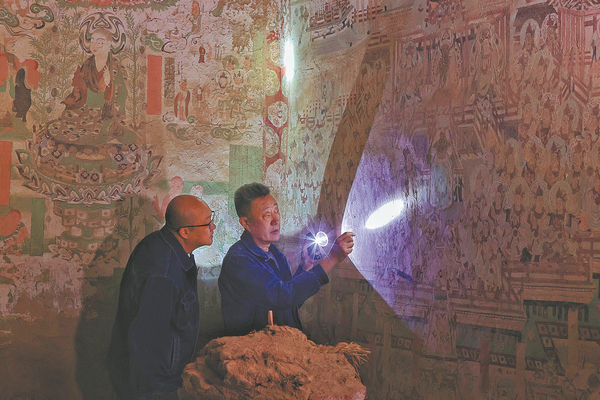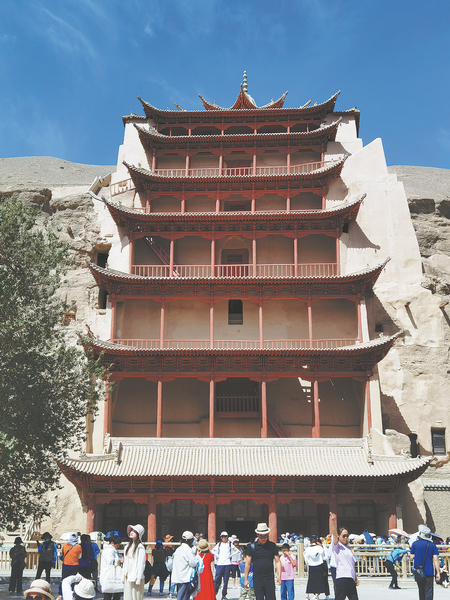DepthReading
Dedicated to a new age of restoration

The spirit of continuity, which spans the generations who protect the caves, remains evident, report Fang Aiqing, Wang Kaihao in Dunhuang, Gansu province, and Ma Jingna in Lanzhou.
It's a race against time, as generations of cultural heritage conservators at the Dunhuang Academy endeavor to protect the artistic charm of the Mogao Caves, a UNESCO World Heritage Site, despite erosion by sand and wind.
Restorer Li Bo is a member of the team that is dedicated to protecting the 45,000 square meters of murals and more than 2,400 painted sculptures of the 735 caves of the site, the construction of which spans a millennium, from the 4th century to the 14th century.
Located in the far west of Northwest China's Gansu province, the city of Dunhuang and its neighboring areas — home to the Mogao Caves and other historical monuments witnessing the apex of the ancient, prosperous Silk Road — just unrolled a saga testifying to communication among civilizations across Eurasia.
While characters on the ancient murals refer to Buddha for the truth of life and the universe — a frequent theme of the murals — Li's pilgrimage to enlightenment is reflected in every moment of him sitting in front of the wall and reviving the revelations in the murals with meticulous hand movements, bit by bit, from dawn to dusk, day after day.
A sophisticated mural restorer like Li, who has spent more than 30 years in the business, can only restore an area about the size of a sheet of paper each day.
The past three decades have seen him repair around 1,500 square meters of murals and more than 300 sculptures — the small ones are only about 20 centimeters tall, while the largest reach more than 20 meters in height.
The years have also brought him the exclusive joy of holding a silent dialogue with the mural characters every working day.
In front of a 10th-century mural featuring a mass audience listening to the Buddha at the Yulin Caves in Guazhou county, around two hours' drive from the Mogao Caves, Li mimicked the facial expressions of the characters when introducing his routine work.

The site, which, archaeologists estimate, dates back to the Northern Wei Dynasty (386-534), shares cultural and artistic consistency with the Mogao Caves. The Dunhuang Academy also oversees the Yulin Caves.
As the mural vividly portrays, some listeners slightly lean forward, thirsty for knowledge. Some are puzzled, some look around. Some whisper to others, while some doze off.
It was Li's most relaxed moment during the interview. He's always been astonished at the ability of the ancient painters to precisely portray the mental state of the characters, and to present dynamic scenes with static images.
"It's a satisfying undertaking rather than a job that I'm obliged to get done. It fills me with joy to think that I have contributed to their survival and inheritance," Li says.
He adds that, as his knowledge accumulates and his understanding toward the artworks deepens, it becomes even more insufferable when his hands cannot keep up with his mind, like a doctor who knows what disease a patient has, but fails to treat it.
In March, he won first prize among mural and painted sculpture restorers at a national vocational skills competition related to cultural relics, which was held in Shanxi province. Nonetheless, there's always the motivation to further improve his skills, he says.

Mural doctors
Commonly seen "diseases" affecting the murals include cracking and flaking, as well as efflorescing that is caused by changes in temperature and humidity of the caves, and the deposition of salts.
To restore a mural requires an all-rounder. The restorer should know painting, master the skills of a mason and have some knowledge of chemistry and physics, to be able to recognize the problems, their corresponding causes and deliver a solution. They must also select proper materials and tools, and conduct experiments, before formally carrying out the restoration and evaluating the effect afterward.
For example, dealing with cracked murals with small flakes curling up usually involves removing the dust, injecting adhesives, backfilling the painted layer, then rolling and pressing to flatten the edges.
Even at the height of summer, when temperatures soar to nearly 40 C, the 58 year old and his colleagues have to wear quilted coats and pants in the caves to keep warm. Arthritis is a hazard for some.
However, for Li Bo, it's often not until he steps out of the caves after several immersive hours that he starts to feel the exhaustion.
Li Lingzhi says Li Bo shares all he knows without reserve.
He says, he's always impressed by the awe displayed by the older generations toward the cultural heritage, and the more comprehensive point of view they have of the tasks.
Li Bo admits that compared to green hands, an experienced restorer spends less time forming up a solution, and meanwhile, they take a greater number of factors consideration.
Category: English
DepthReading
Key words:
